Terrorism and Freight Safety: Australia's Transportation Security
VerifiedAdded on 2023/06/12
|8
|2225
|179
Essay
AI Summary
This research paper examines the critical importance of freight transportation safety and security in Australia, with a specific focus on the escalating threat of terrorism. It begins by outlining the various modes of freight transport in Australia and the inherent security risks associated with each. The paper then delves into the background of global terrorism and its specific impact on Australian carriers, highlighting the vulnerabilities across air, water, rail, and motor transport. It analyzes the increased operational costs and logistical challenges faced by the Australian logistics industry due to terrorism, including the need for enhanced security measures and cargo handling procedures. Furthermore, the essay provides a comprehensive set of recommendations for carriers to mitigate these risks, emphasizing collaboration with intelligence agencies, investment in security infrastructure, enhanced training for personnel, and continuous review of security protocols. The paper concludes by underscoring the need for constant vigilance and proactive measures to safeguard freight transportation in Australia against the evolving threat of terrorism. Desklib offers more resources, including similar essays and study tools.
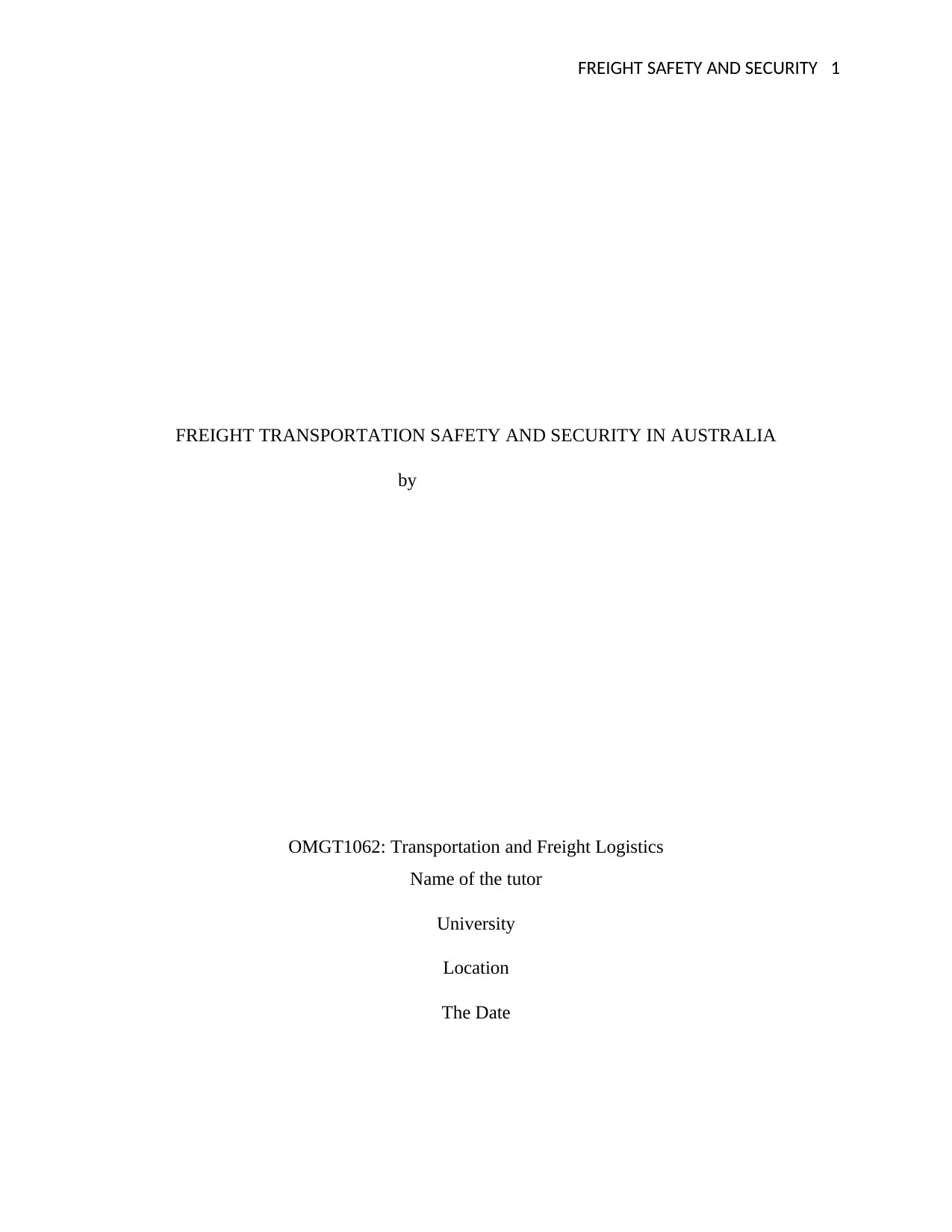
FREIGHT SAFETY AND SECURITY 1
FREIGHT TRANSPORTATION SAFETY AND SECURITY IN AUSTRALIA
by
OMGT1062: Transportation and Freight Logistics
Name of the tutor
University
Location
The Date
FREIGHT TRANSPORTATION SAFETY AND SECURITY IN AUSTRALIA
by
OMGT1062: Transportation and Freight Logistics
Name of the tutor
University
Location
The Date
Paraphrase This Document
Need a fresh take? Get an instant paraphrase of this document with our AI Paraphraser
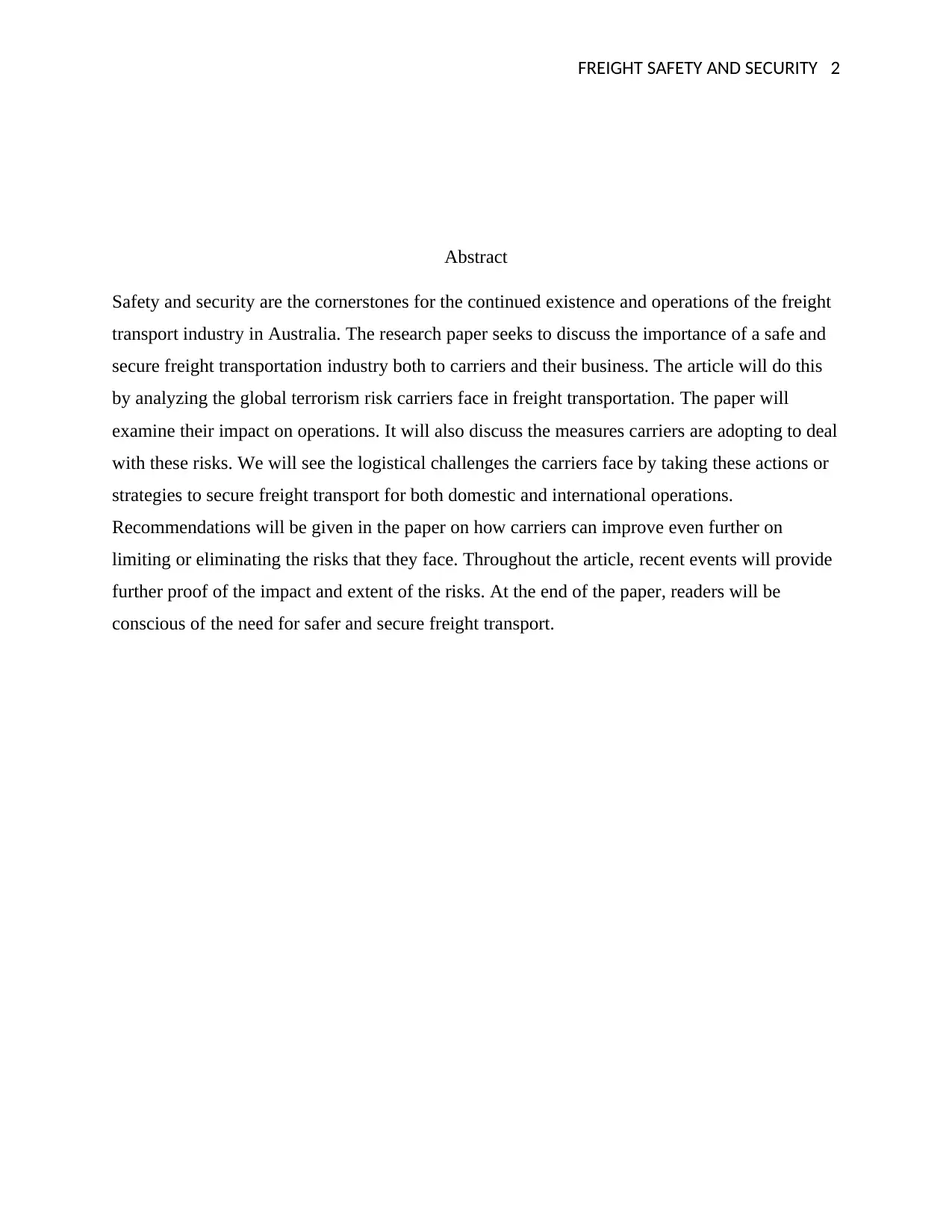
FREIGHT SAFETY AND SECURITY 2
Abstract
Safety and security are the cornerstones for the continued existence and operations of the freight
transport industry in Australia. The research paper seeks to discuss the importance of a safe and
secure freight transportation industry both to carriers and their business. The article will do this
by analyzing the global terrorism risk carriers face in freight transportation. The paper will
examine their impact on operations. It will also discuss the measures carriers are adopting to deal
with these risks. We will see the logistical challenges the carriers face by taking these actions or
strategies to secure freight transport for both domestic and international operations.
Recommendations will be given in the paper on how carriers can improve even further on
limiting or eliminating the risks that they face. Throughout the article, recent events will provide
further proof of the impact and extent of the risks. At the end of the paper, readers will be
conscious of the need for safer and secure freight transport.
Abstract
Safety and security are the cornerstones for the continued existence and operations of the freight
transport industry in Australia. The research paper seeks to discuss the importance of a safe and
secure freight transportation industry both to carriers and their business. The article will do this
by analyzing the global terrorism risk carriers face in freight transportation. The paper will
examine their impact on operations. It will also discuss the measures carriers are adopting to deal
with these risks. We will see the logistical challenges the carriers face by taking these actions or
strategies to secure freight transport for both domestic and international operations.
Recommendations will be given in the paper on how carriers can improve even further on
limiting or eliminating the risks that they face. Throughout the article, recent events will provide
further proof of the impact and extent of the risks. At the end of the paper, readers will be
conscious of the need for safer and secure freight transport.
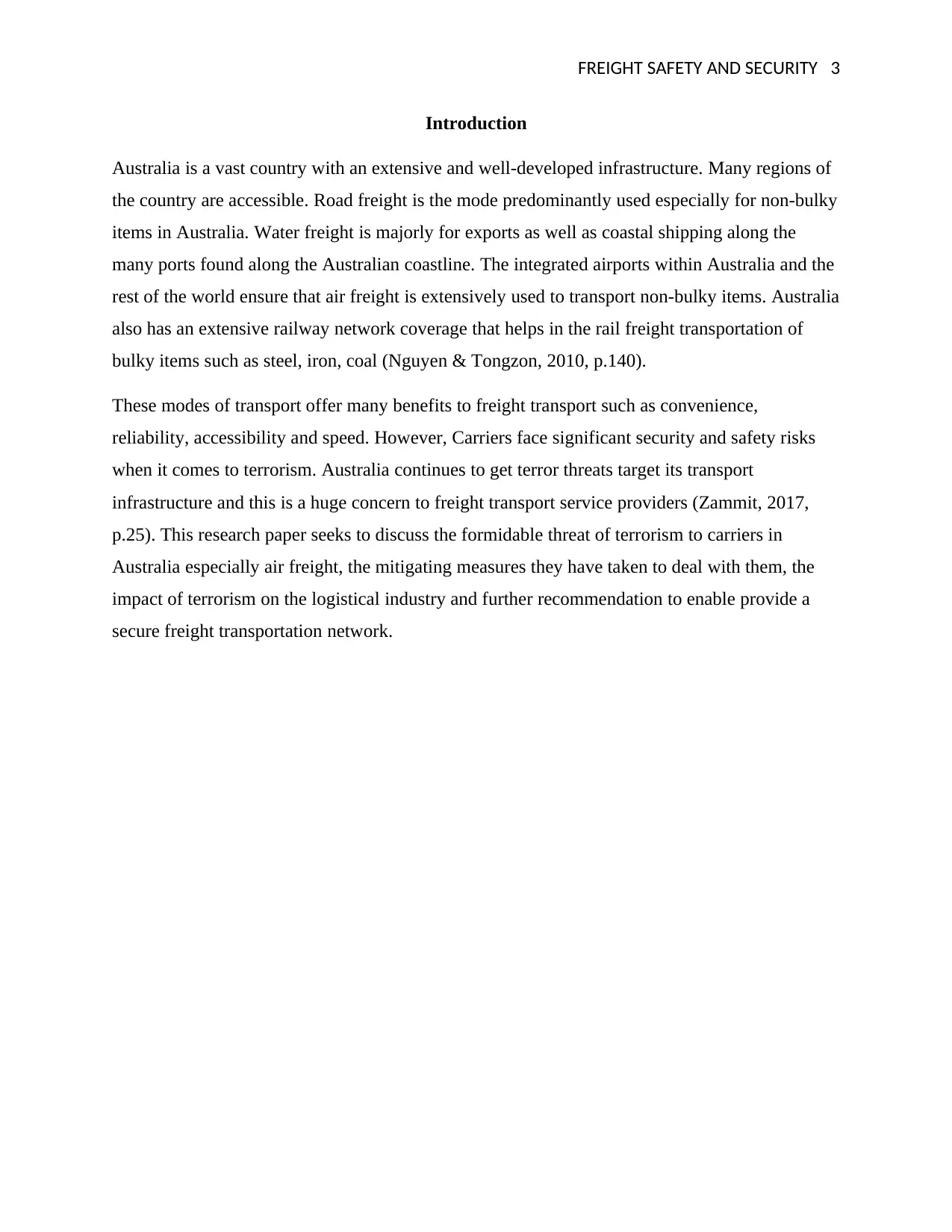
FREIGHT SAFETY AND SECURITY 3
Introduction
Australia is a vast country with an extensive and well-developed infrastructure. Many regions of
the country are accessible. Road freight is the mode predominantly used especially for non-bulky
items in Australia. Water freight is majorly for exports as well as coastal shipping along the
many ports found along the Australian coastline. The integrated airports within Australia and the
rest of the world ensure that air freight is extensively used to transport non-bulky items. Australia
also has an extensive railway network coverage that helps in the rail freight transportation of
bulky items such as steel, iron, coal (Nguyen & Tongzon, 2010, p.140).
These modes of transport offer many benefits to freight transport such as convenience,
reliability, accessibility and speed. However, Carriers face significant security and safety risks
when it comes to terrorism. Australia continues to get terror threats target its transport
infrastructure and this is a huge concern to freight transport service providers (Zammit, 2017,
p.25). This research paper seeks to discuss the formidable threat of terrorism to carriers in
Australia especially air freight, the mitigating measures they have taken to deal with them, the
impact of terrorism on the logistical industry and further recommendation to enable provide a
secure freight transportation network.
Introduction
Australia is a vast country with an extensive and well-developed infrastructure. Many regions of
the country are accessible. Road freight is the mode predominantly used especially for non-bulky
items in Australia. Water freight is majorly for exports as well as coastal shipping along the
many ports found along the Australian coastline. The integrated airports within Australia and the
rest of the world ensure that air freight is extensively used to transport non-bulky items. Australia
also has an extensive railway network coverage that helps in the rail freight transportation of
bulky items such as steel, iron, coal (Nguyen & Tongzon, 2010, p.140).
These modes of transport offer many benefits to freight transport such as convenience,
reliability, accessibility and speed. However, Carriers face significant security and safety risks
when it comes to terrorism. Australia continues to get terror threats target its transport
infrastructure and this is a huge concern to freight transport service providers (Zammit, 2017,
p.25). This research paper seeks to discuss the formidable threat of terrorism to carriers in
Australia especially air freight, the mitigating measures they have taken to deal with them, the
impact of terrorism on the logistical industry and further recommendation to enable provide a
secure freight transportation network.
⊘ This is a preview!⊘
Do you want full access?
Subscribe today to unlock all pages.

Trusted by 1+ million students worldwide
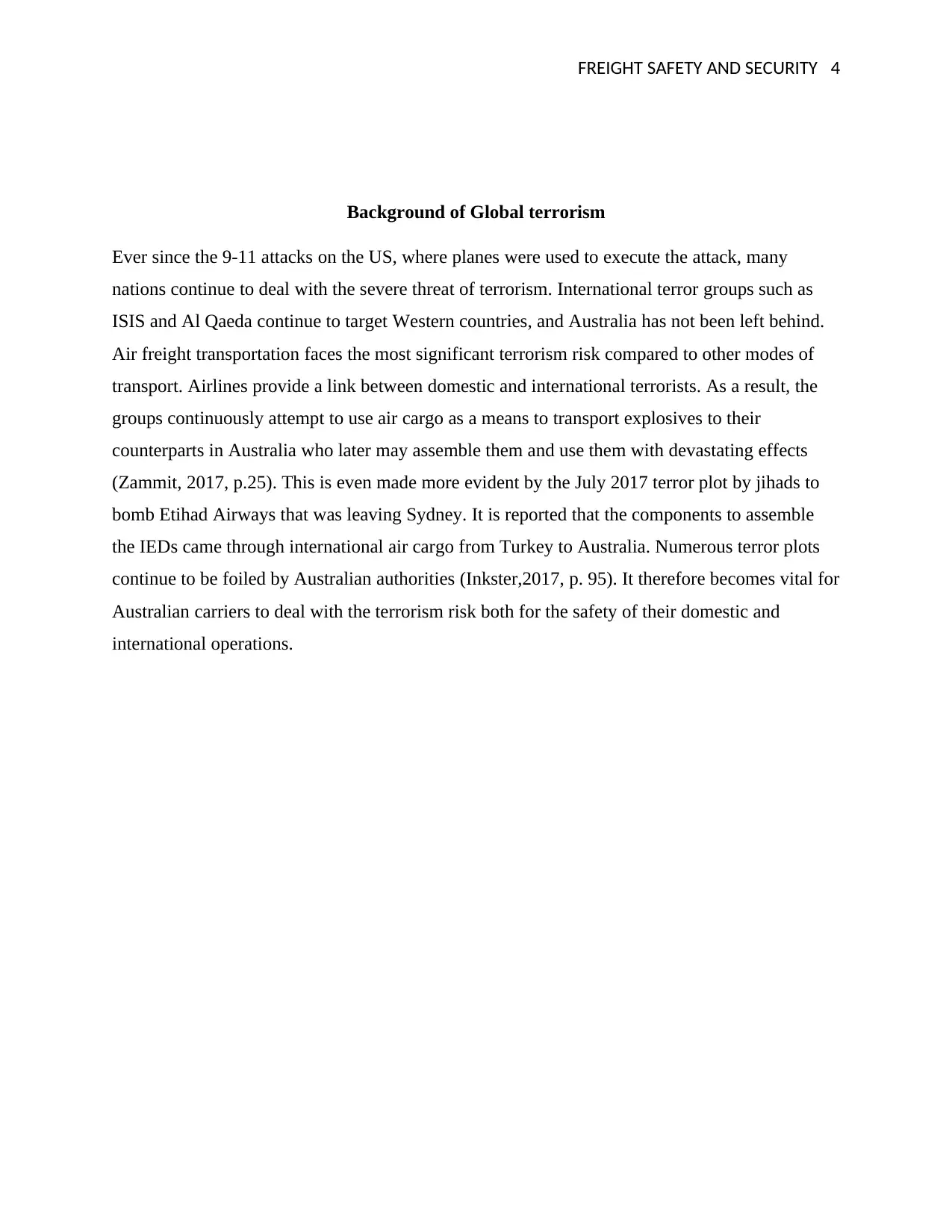
FREIGHT SAFETY AND SECURITY 4
Background of Global terrorism
Ever since the 9-11 attacks on the US, where planes were used to execute the attack, many
nations continue to deal with the severe threat of terrorism. International terror groups such as
ISIS and Al Qaeda continue to target Western countries, and Australia has not been left behind.
Air freight transportation faces the most significant terrorism risk compared to other modes of
transport. Airlines provide a link between domestic and international terrorists. As a result, the
groups continuously attempt to use air cargo as a means to transport explosives to their
counterparts in Australia who later may assemble them and use them with devastating effects
(Zammit, 2017, p.25). This is even made more evident by the July 2017 terror plot by jihads to
bomb Etihad Airways that was leaving Sydney. It is reported that the components to assemble
the IEDs came through international air cargo from Turkey to Australia. Numerous terror plots
continue to be foiled by Australian authorities (Inkster,2017, p. 95). It therefore becomes vital for
Australian carriers to deal with the terrorism risk both for the safety of their domestic and
international operations.
Background of Global terrorism
Ever since the 9-11 attacks on the US, where planes were used to execute the attack, many
nations continue to deal with the severe threat of terrorism. International terror groups such as
ISIS and Al Qaeda continue to target Western countries, and Australia has not been left behind.
Air freight transportation faces the most significant terrorism risk compared to other modes of
transport. Airlines provide a link between domestic and international terrorists. As a result, the
groups continuously attempt to use air cargo as a means to transport explosives to their
counterparts in Australia who later may assemble them and use them with devastating effects
(Zammit, 2017, p.25). This is even made more evident by the July 2017 terror plot by jihads to
bomb Etihad Airways that was leaving Sydney. It is reported that the components to assemble
the IEDs came through international air cargo from Turkey to Australia. Numerous terror plots
continue to be foiled by Australian authorities (Inkster,2017, p. 95). It therefore becomes vital for
Australian carriers to deal with the terrorism risk both for the safety of their domestic and
international operations.
Paraphrase This Document
Need a fresh take? Get an instant paraphrase of this document with our AI Paraphraser
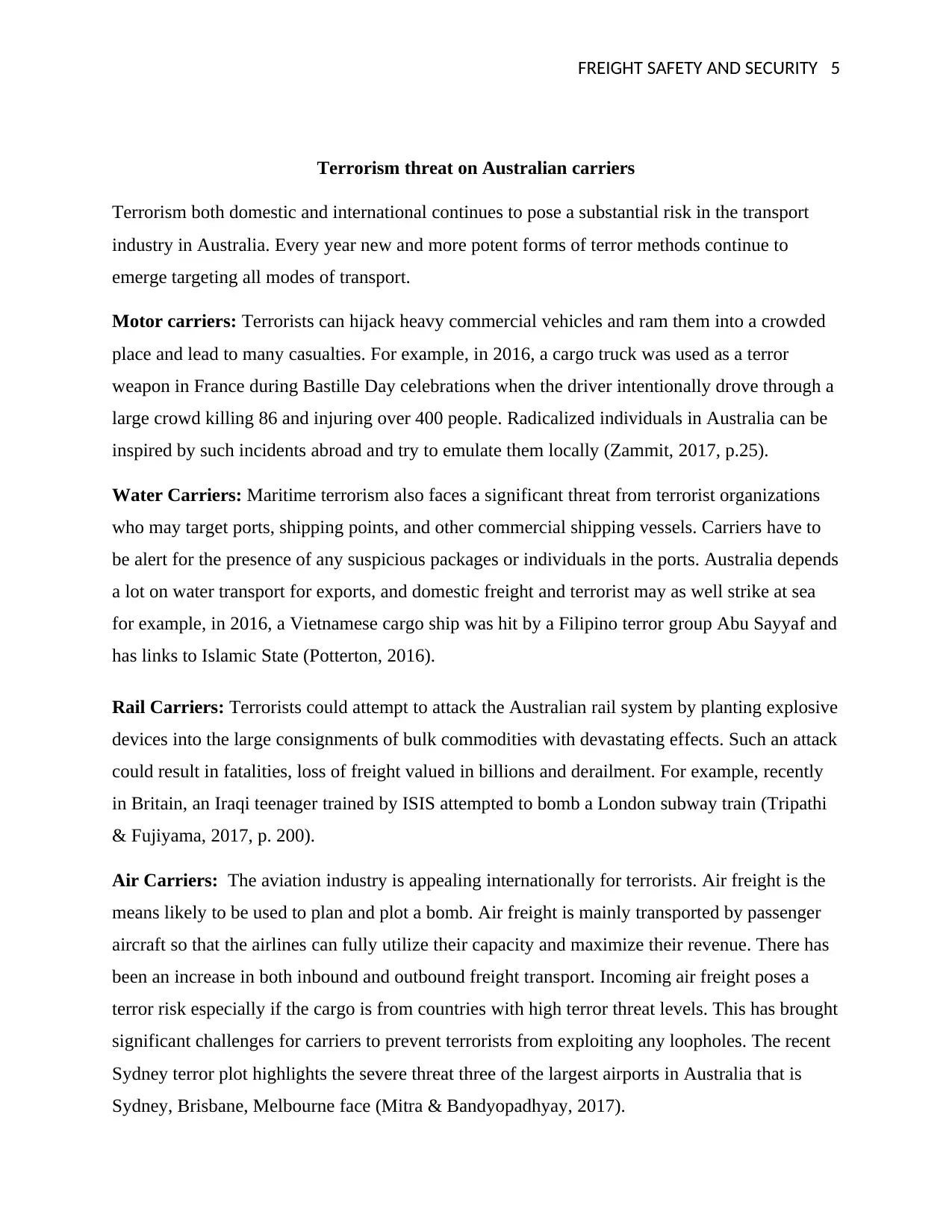
FREIGHT SAFETY AND SECURITY 5
Terrorism threat on Australian carriers
Terrorism both domestic and international continues to pose a substantial risk in the transport
industry in Australia. Every year new and more potent forms of terror methods continue to
emerge targeting all modes of transport.
Motor carriers: Terrorists can hijack heavy commercial vehicles and ram them into a crowded
place and lead to many casualties. For example, in 2016, a cargo truck was used as a terror
weapon in France during Bastille Day celebrations when the driver intentionally drove through a
large crowd killing 86 and injuring over 400 people. Radicalized individuals in Australia can be
inspired by such incidents abroad and try to emulate them locally (Zammit, 2017, p.25).
Water Carriers: Maritime terrorism also faces a significant threat from terrorist organizations
who may target ports, shipping points, and other commercial shipping vessels. Carriers have to
be alert for the presence of any suspicious packages or individuals in the ports. Australia depends
a lot on water transport for exports, and domestic freight and terrorist may as well strike at sea
for example, in 2016, a Vietnamese cargo ship was hit by a Filipino terror group Abu Sayyaf and
has links to Islamic State (Potterton, 2016).
Rail Carriers: Terrorists could attempt to attack the Australian rail system by planting explosive
devices into the large consignments of bulk commodities with devastating effects. Such an attack
could result in fatalities, loss of freight valued in billions and derailment. For example, recently
in Britain, an Iraqi teenager trained by ISIS attempted to bomb a London subway train (Tripathi
& Fujiyama, 2017, p. 200).
Air Carriers: The aviation industry is appealing internationally for terrorists. Air freight is the
means likely to be used to plan and plot a bomb. Air freight is mainly transported by passenger
aircraft so that the airlines can fully utilize their capacity and maximize their revenue. There has
been an increase in both inbound and outbound freight transport. Incoming air freight poses a
terror risk especially if the cargo is from countries with high terror threat levels. This has brought
significant challenges for carriers to prevent terrorists from exploiting any loopholes. The recent
Sydney terror plot highlights the severe threat three of the largest airports in Australia that is
Sydney, Brisbane, Melbourne face (Mitra & Bandyopadhyay, 2017).
Terrorism threat on Australian carriers
Terrorism both domestic and international continues to pose a substantial risk in the transport
industry in Australia. Every year new and more potent forms of terror methods continue to
emerge targeting all modes of transport.
Motor carriers: Terrorists can hijack heavy commercial vehicles and ram them into a crowded
place and lead to many casualties. For example, in 2016, a cargo truck was used as a terror
weapon in France during Bastille Day celebrations when the driver intentionally drove through a
large crowd killing 86 and injuring over 400 people. Radicalized individuals in Australia can be
inspired by such incidents abroad and try to emulate them locally (Zammit, 2017, p.25).
Water Carriers: Maritime terrorism also faces a significant threat from terrorist organizations
who may target ports, shipping points, and other commercial shipping vessels. Carriers have to
be alert for the presence of any suspicious packages or individuals in the ports. Australia depends
a lot on water transport for exports, and domestic freight and terrorist may as well strike at sea
for example, in 2016, a Vietnamese cargo ship was hit by a Filipino terror group Abu Sayyaf and
has links to Islamic State (Potterton, 2016).
Rail Carriers: Terrorists could attempt to attack the Australian rail system by planting explosive
devices into the large consignments of bulk commodities with devastating effects. Such an attack
could result in fatalities, loss of freight valued in billions and derailment. For example, recently
in Britain, an Iraqi teenager trained by ISIS attempted to bomb a London subway train (Tripathi
& Fujiyama, 2017, p. 200).
Air Carriers: The aviation industry is appealing internationally for terrorists. Air freight is the
means likely to be used to plan and plot a bomb. Air freight is mainly transported by passenger
aircraft so that the airlines can fully utilize their capacity and maximize their revenue. There has
been an increase in both inbound and outbound freight transport. Incoming air freight poses a
terror risk especially if the cargo is from countries with high terror threat levels. This has brought
significant challenges for carriers to prevent terrorists from exploiting any loopholes. The recent
Sydney terror plot highlights the severe threat three of the largest airports in Australia that is
Sydney, Brisbane, Melbourne face (Mitra & Bandyopadhyay, 2017).
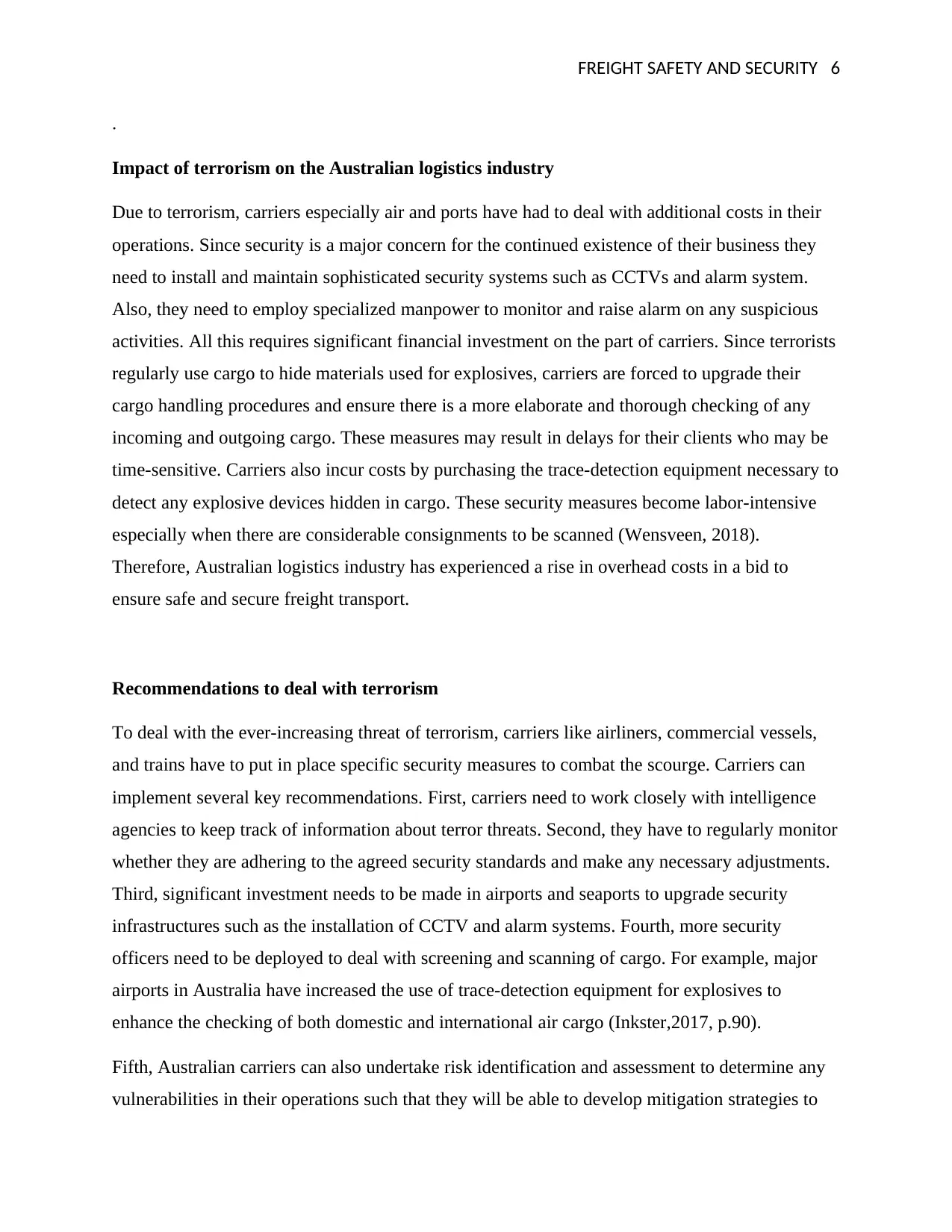
FREIGHT SAFETY AND SECURITY 6
.
Impact of terrorism on the Australian logistics industry
Due to terrorism, carriers especially air and ports have had to deal with additional costs in their
operations. Since security is a major concern for the continued existence of their business they
need to install and maintain sophisticated security systems such as CCTVs and alarm system.
Also, they need to employ specialized manpower to monitor and raise alarm on any suspicious
activities. All this requires significant financial investment on the part of carriers. Since terrorists
regularly use cargo to hide materials used for explosives, carriers are forced to upgrade their
cargo handling procedures and ensure there is a more elaborate and thorough checking of any
incoming and outgoing cargo. These measures may result in delays for their clients who may be
time-sensitive. Carriers also incur costs by purchasing the trace-detection equipment necessary to
detect any explosive devices hidden in cargo. These security measures become labor-intensive
especially when there are considerable consignments to be scanned (Wensveen, 2018).
Therefore, Australian logistics industry has experienced a rise in overhead costs in a bid to
ensure safe and secure freight transport.
Recommendations to deal with terrorism
To deal with the ever-increasing threat of terrorism, carriers like airliners, commercial vessels,
and trains have to put in place specific security measures to combat the scourge. Carriers can
implement several key recommendations. First, carriers need to work closely with intelligence
agencies to keep track of information about terror threats. Second, they have to regularly monitor
whether they are adhering to the agreed security standards and make any necessary adjustments.
Third, significant investment needs to be made in airports and seaports to upgrade security
infrastructures such as the installation of CCTV and alarm systems. Fourth, more security
officers need to be deployed to deal with screening and scanning of cargo. For example, major
airports in Australia have increased the use of trace-detection equipment for explosives to
enhance the checking of both domestic and international air cargo (Inkster,2017, p.90).
Fifth, Australian carriers can also undertake risk identification and assessment to determine any
vulnerabilities in their operations such that they will be able to develop mitigation strategies to
.
Impact of terrorism on the Australian logistics industry
Due to terrorism, carriers especially air and ports have had to deal with additional costs in their
operations. Since security is a major concern for the continued existence of their business they
need to install and maintain sophisticated security systems such as CCTVs and alarm system.
Also, they need to employ specialized manpower to monitor and raise alarm on any suspicious
activities. All this requires significant financial investment on the part of carriers. Since terrorists
regularly use cargo to hide materials used for explosives, carriers are forced to upgrade their
cargo handling procedures and ensure there is a more elaborate and thorough checking of any
incoming and outgoing cargo. These measures may result in delays for their clients who may be
time-sensitive. Carriers also incur costs by purchasing the trace-detection equipment necessary to
detect any explosive devices hidden in cargo. These security measures become labor-intensive
especially when there are considerable consignments to be scanned (Wensveen, 2018).
Therefore, Australian logistics industry has experienced a rise in overhead costs in a bid to
ensure safe and secure freight transport.
Recommendations to deal with terrorism
To deal with the ever-increasing threat of terrorism, carriers like airliners, commercial vessels,
and trains have to put in place specific security measures to combat the scourge. Carriers can
implement several key recommendations. First, carriers need to work closely with intelligence
agencies to keep track of information about terror threats. Second, they have to regularly monitor
whether they are adhering to the agreed security standards and make any necessary adjustments.
Third, significant investment needs to be made in airports and seaports to upgrade security
infrastructures such as the installation of CCTV and alarm systems. Fourth, more security
officers need to be deployed to deal with screening and scanning of cargo. For example, major
airports in Australia have increased the use of trace-detection equipment for explosives to
enhance the checking of both domestic and international air cargo (Inkster,2017, p.90).
Fifth, Australian carriers can also undertake risk identification and assessment to determine any
vulnerabilities in their operations such that they will be able to develop mitigation strategies to
⊘ This is a preview!⊘
Do you want full access?
Subscribe today to unlock all pages.

Trusted by 1+ million students worldwide
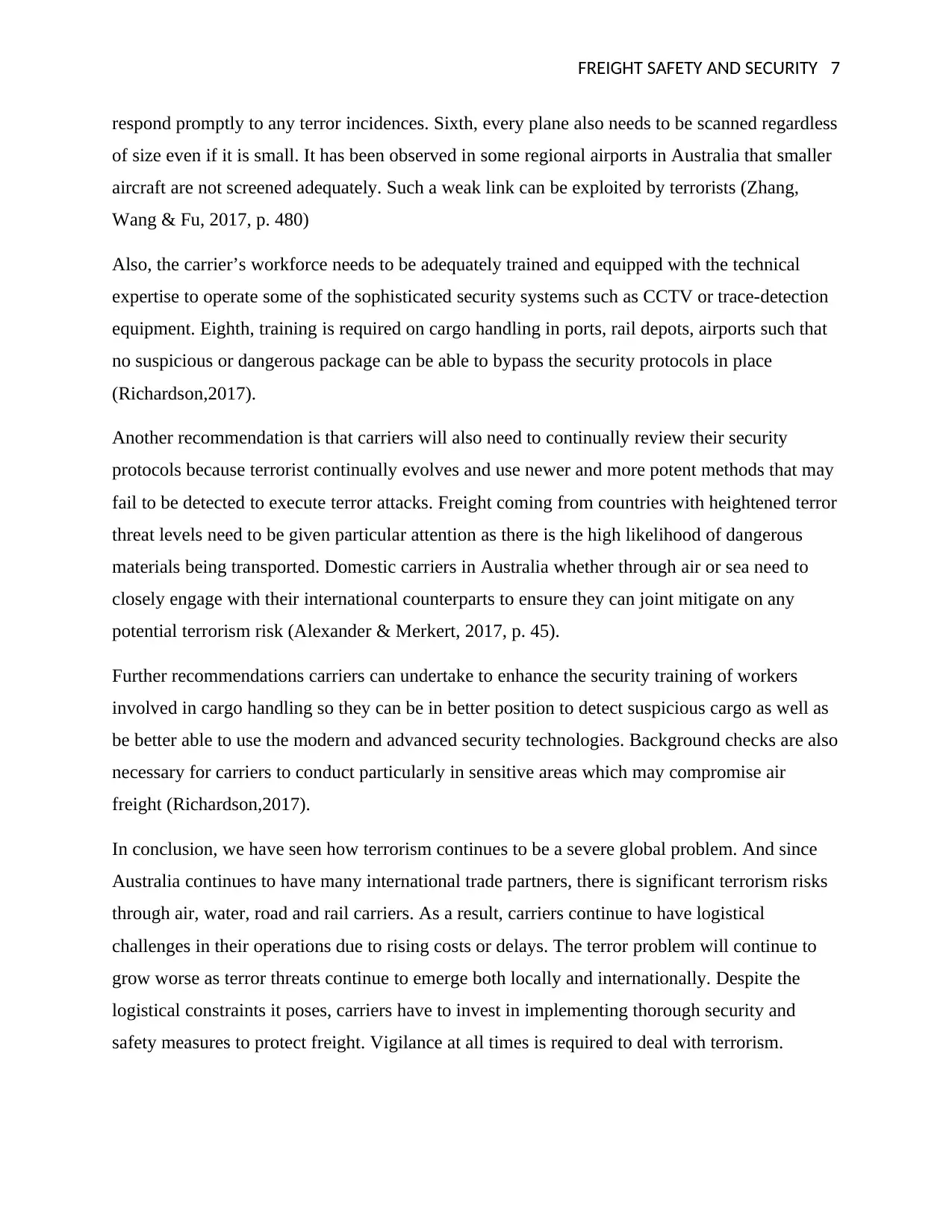
FREIGHT SAFETY AND SECURITY 7
respond promptly to any terror incidences. Sixth, every plane also needs to be scanned regardless
of size even if it is small. It has been observed in some regional airports in Australia that smaller
aircraft are not screened adequately. Such a weak link can be exploited by terrorists (Zhang,
Wang & Fu, 2017, p. 480)
Also, the carrier’s workforce needs to be adequately trained and equipped with the technical
expertise to operate some of the sophisticated security systems such as CCTV or trace-detection
equipment. Eighth, training is required on cargo handling in ports, rail depots, airports such that
no suspicious or dangerous package can be able to bypass the security protocols in place
(Richardson,2017).
Another recommendation is that carriers will also need to continually review their security
protocols because terrorist continually evolves and use newer and more potent methods that may
fail to be detected to execute terror attacks. Freight coming from countries with heightened terror
threat levels need to be given particular attention as there is the high likelihood of dangerous
materials being transported. Domestic carriers in Australia whether through air or sea need to
closely engage with their international counterparts to ensure they can joint mitigate on any
potential terrorism risk (Alexander & Merkert, 2017, p. 45).
Further recommendations carriers can undertake to enhance the security training of workers
involved in cargo handling so they can be in better position to detect suspicious cargo as well as
be better able to use the modern and advanced security technologies. Background checks are also
necessary for carriers to conduct particularly in sensitive areas which may compromise air
freight (Richardson,2017).
In conclusion, we have seen how terrorism continues to be a severe global problem. And since
Australia continues to have many international trade partners, there is significant terrorism risks
through air, water, road and rail carriers. As a result, carriers continue to have logistical
challenges in their operations due to rising costs or delays. The terror problem will continue to
grow worse as terror threats continue to emerge both locally and internationally. Despite the
logistical constraints it poses, carriers have to invest in implementing thorough security and
safety measures to protect freight. Vigilance at all times is required to deal with terrorism.
respond promptly to any terror incidences. Sixth, every plane also needs to be scanned regardless
of size even if it is small. It has been observed in some regional airports in Australia that smaller
aircraft are not screened adequately. Such a weak link can be exploited by terrorists (Zhang,
Wang & Fu, 2017, p. 480)
Also, the carrier’s workforce needs to be adequately trained and equipped with the technical
expertise to operate some of the sophisticated security systems such as CCTV or trace-detection
equipment. Eighth, training is required on cargo handling in ports, rail depots, airports such that
no suspicious or dangerous package can be able to bypass the security protocols in place
(Richardson,2017).
Another recommendation is that carriers will also need to continually review their security
protocols because terrorist continually evolves and use newer and more potent methods that may
fail to be detected to execute terror attacks. Freight coming from countries with heightened terror
threat levels need to be given particular attention as there is the high likelihood of dangerous
materials being transported. Domestic carriers in Australia whether through air or sea need to
closely engage with their international counterparts to ensure they can joint mitigate on any
potential terrorism risk (Alexander & Merkert, 2017, p. 45).
Further recommendations carriers can undertake to enhance the security training of workers
involved in cargo handling so they can be in better position to detect suspicious cargo as well as
be better able to use the modern and advanced security technologies. Background checks are also
necessary for carriers to conduct particularly in sensitive areas which may compromise air
freight (Richardson,2017).
In conclusion, we have seen how terrorism continues to be a severe global problem. And since
Australia continues to have many international trade partners, there is significant terrorism risks
through air, water, road and rail carriers. As a result, carriers continue to have logistical
challenges in their operations due to rising costs or delays. The terror problem will continue to
grow worse as terror threats continue to emerge both locally and internationally. Despite the
logistical constraints it poses, carriers have to invest in implementing thorough security and
safety measures to protect freight. Vigilance at all times is required to deal with terrorism.
Paraphrase This Document
Need a fresh take? Get an instant paraphrase of this document with our AI Paraphraser
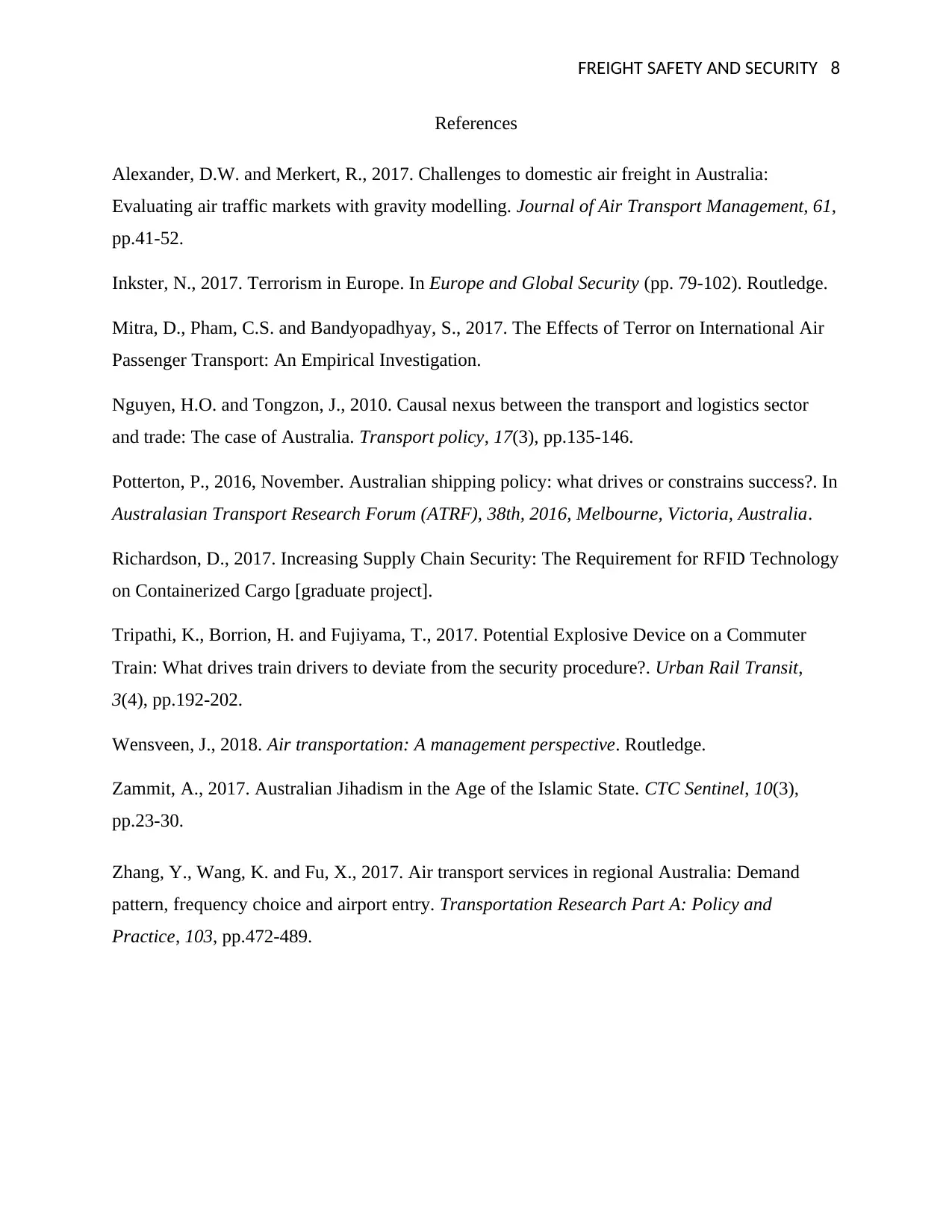
FREIGHT SAFETY AND SECURITY 8
References
Alexander, D.W. and Merkert, R., 2017. Challenges to domestic air freight in Australia:
Evaluating air traffic markets with gravity modelling. Journal of Air Transport Management, 61,
pp.41-52.
Inkster, N., 2017. Terrorism in Europe. In Europe and Global Security (pp. 79-102). Routledge.
Mitra, D., Pham, C.S. and Bandyopadhyay, S., 2017. The Effects of Terror on International Air
Passenger Transport: An Empirical Investigation.
Nguyen, H.O. and Tongzon, J., 2010. Causal nexus between the transport and logistics sector
and trade: The case of Australia. Transport policy, 17(3), pp.135-146.
Potterton, P., 2016, November. Australian shipping policy: what drives or constrains success?. In
Australasian Transport Research Forum (ATRF), 38th, 2016, Melbourne, Victoria, Australia.
Richardson, D., 2017. Increasing Supply Chain Security: The Requirement for RFID Technology
on Containerized Cargo [graduate project].
Tripathi, K., Borrion, H. and Fujiyama, T., 2017. Potential Explosive Device on a Commuter
Train: What drives train drivers to deviate from the security procedure?. Urban Rail Transit,
3(4), pp.192-202.
Wensveen, J., 2018. Air transportation: A management perspective. Routledge.
Zammit, A., 2017. Australian Jihadism in the Age of the Islamic State. CTC Sentinel, 10(3),
pp.23-30.
Zhang, Y., Wang, K. and Fu, X., 2017. Air transport services in regional Australia: Demand
pattern, frequency choice and airport entry. Transportation Research Part A: Policy and
Practice, 103, pp.472-489.
References
Alexander, D.W. and Merkert, R., 2017. Challenges to domestic air freight in Australia:
Evaluating air traffic markets with gravity modelling. Journal of Air Transport Management, 61,
pp.41-52.
Inkster, N., 2017. Terrorism in Europe. In Europe and Global Security (pp. 79-102). Routledge.
Mitra, D., Pham, C.S. and Bandyopadhyay, S., 2017. The Effects of Terror on International Air
Passenger Transport: An Empirical Investigation.
Nguyen, H.O. and Tongzon, J., 2010. Causal nexus between the transport and logistics sector
and trade: The case of Australia. Transport policy, 17(3), pp.135-146.
Potterton, P., 2016, November. Australian shipping policy: what drives or constrains success?. In
Australasian Transport Research Forum (ATRF), 38th, 2016, Melbourne, Victoria, Australia.
Richardson, D., 2017. Increasing Supply Chain Security: The Requirement for RFID Technology
on Containerized Cargo [graduate project].
Tripathi, K., Borrion, H. and Fujiyama, T., 2017. Potential Explosive Device on a Commuter
Train: What drives train drivers to deviate from the security procedure?. Urban Rail Transit,
3(4), pp.192-202.
Wensveen, J., 2018. Air transportation: A management perspective. Routledge.
Zammit, A., 2017. Australian Jihadism in the Age of the Islamic State. CTC Sentinel, 10(3),
pp.23-30.
Zhang, Y., Wang, K. and Fu, X., 2017. Air transport services in regional Australia: Demand
pattern, frequency choice and airport entry. Transportation Research Part A: Policy and
Practice, 103, pp.472-489.
1 out of 8
Your All-in-One AI-Powered Toolkit for Academic Success.
+13062052269
info@desklib.com
Available 24*7 on WhatsApp / Email
![[object Object]](/_next/static/media/star-bottom.7253800d.svg)
Unlock your academic potential
Copyright © 2020–2025 A2Z Services. All Rights Reserved. Developed and managed by ZUCOL.


